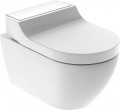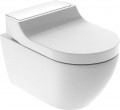Bidet functions
Built into the toilet, allowing it to be used as a bidet - a hygienic bath for washing the external genitals and anus after using the toilet. Toilet bowls with similar functionality are by definition equipped with
hygienic shower (with one or
>multiple operation modes); in addition, they may also include Water heating and/or
self-cleaning nozzle. Here is a detailed description of these features:
— Hygienic shower. This function is the whole essence of the bidet: a hygienic shower is a device with which you can wash the perineum after using the toilet. Theoretically, such a shower can have a different design, but in the toilet bowls most often there is the most simple and compact version - a small tube built directly into the rim of the bowl in such a position that the stream of water from it gets «clearly on purpose». Another option is a cover and a seat, supplemented by its own hygienic shower; a similar cover in many models can even be removed and moved to another bowl, if necessary.
Also in the characteristics often specify the number of hygienic shower modes. Most often this mode is one - this is enough for most cases. However, there are exceptions - for example, the design may provide «male» and «female» modes (taking into account anatomical differences between the sexes)the function of massage and so on. N. In some models, t
...he number of modes reaches 7. In any case, if the formats of work are more than one - their particular set will not hurt to clarify separately; and the increase in the number of modes inevitably affects the cost.
— Water heating. Built-in heater for water supplied to hygienic shower. By default, such a shower uses ordinary cold water, and this is not always and not for everyone comfortable. Heating the water helps to remedy the situation; however, it should be borne in mind that this function has a significant impact on the price of the toilet, and the heater requires connection to the electrical network.
— Self-cleaning. The automatic cleaning function typically uses both flush and hygienic shower (therefore self-cleaning and refer to the functions of bidet); but other features of such systems can be different, depending on the model. Thus, in some toilets this mode is switched on periodically after a certain time or a certain number of flushes, in others - after each flush, in the third used pollution sensor, determining the need for cleaning, etc. Anyway, This function significantly increases hygiene and makes cleanliness easier to maintain. For example, regular self-cleaning significantly reduces the likelihood that the genitals will become contaminated during the use of the shower or harmful microbes; and manual cleaning of the toilet becomes easier and less frequent.Smart features
Additional functions of the toilet bowl, realized due to electronic «filling» and other special equipment. These features do not affect the basic functionality of the product, but they can significantly improve comfort or even safety when used. Among the most popular smart features in our time are
presence sensor,
automatic drain,
air drying,
auto-lift (lowering) seat,
, heater/list, Smartphone management,
Child protection and
Backlight. Elaborate on each one:
— Presence sensor. Sensor, responding to the appearance of a person near the toilet. This sensor is mainly used to automatically control other functions. For example, in some toilets the presence sensor provides automatic lifting of the lid when a person approaches and lowering - when removed; in others it includes seat heating, controls the flush, etc. The specific features of the sensor work should be specified separately. However, in any case, this feature provides not only additional convenience, but also hygiene: the user does not need to touch hands buttons and other controls. Such functionality may also be useful if the toilet is used by a person with disabilities, who for one reason or another is difficult t
...o use more traditional management.
— Automatic drain. A feature that eliminates the need to flush the water manually. Typically based on the presence sensor described above: a drain is usually turned on after the sensor stops detecting the presence of a person on or near the toilet. Such a possibility gives several advantages over a more traditional design, with manual drainage of water. First, it increases hygiene: do not need to touch hands, buttons and other elements of the toilet. This is especially useful in public toilets (in offices, cafes/restaurants, railway stations, etc.), but it will not be superfluous at home. Secondly, with such toilet bowl in principle impossible situation «forgot to flush». Third, auto-dumping can be a lifesaver for users who, for some reason (old age, disability, health problems) find it difficult to use traditional systems. The notable drawbacks of this feature can be attributed to only a rather high cost.
— Pre-drain. The essence of this function is that before each use a thin layer of water is sprayed on the inside surface of the toilet bowl. This has two advantages. Firstly, by opening the lid, the user sees a clean, neat surface and does not feel any foreign odors that could remain after past use. Secondly, when using the toilet, solid waste is practically not stuck to the wet surface, and the main drain is obtained as efficiently as possible. Usually, the pre-discharge is activated automatically by signal from the presence sensor or by lifting the lid.
— Odour removal. Odor removal device built directly into the toilet. The specific implementation of this function may vary. For example, some models use a device like a removable toilet freshener - a container filled with a special composition. When drained, the water passes through this container, and the substances contained therein neutralize excess odors and create a pleasant aroma. In more advanced toilets, a mini-hood-like system can be installed - with a fan and integrated filter (such as carbon) that purifies air at the molecular level.
— Air drying. Function supplementing hygienic shower (cf. «Bidet functions»). After use, the shower is switched on (manually or automatically) a warm air flow that effectively dries the skin. This eliminates the need to remove excess moisture with toilet paper or napkins.
— Seat auto up/down. A mechanism that eliminates the need for the user to lift and lower the seat (and most often the cover) manually. Methods of control of such mechanism can be different: in some models it is activated manually (by pressing a button, approaching the hand or foot to the contactless sensor, from the remote control, etc. 1), in others - it is triggered automatically by commands from the presence sensor. However, in any case, this function has two main advantages. First, it promotes hygiene - the user does not need to touch the seat and cover with his hands. Secondly, lifting and lowering occur very smoothly, without bumps and excessive noise (which is not always avoided when using traditional seats/covers).
— Seat heating. Heating system that increases the temperature of the seat to comfortable. This feature will be especially appreciated by users who tend to freeze even at room temperature. Also, it will definitely be more useful in two cases. The first - if the seat material itself is not very comfortable and even in a warm room can be perceived as cold. The second - if the air temperature in the bathroom can drop: for example, the room has a window that opens periodically for ventilation even in the cold season. Electric heaters operated by the network are usually used to heat the seats.
— Display. Own display mounted directly on the toilet bowl - usually on the lid or in the back, behind the lid. It is usually the simplest single-color LCD screen capable of displaying numbers and a limited number of characters. However, given the specificity of the application, more is usually not required. The display usually displays such data as the temperature of the seat or water in the hygienic shower, the chosen mode of operation of this shower, and so on. n.
— Remote control. Separate remote control that allows you to control the functions of the toilet (drain, lift/lowering the seat, hygienic shower, etc.). Unlike more traditional remote controls, a control device for a toilet bowl usually involves mounting in one place - on the wall of the toilet, or even right on the bowl. In any case, the remote gives additional convenience: all important functions are combined in one device, located at hand. Of course, it makes sense to apply such management only in advanced models with plenty of accessibility.
— Smartphone control. Ability to control the settings and functions of the toilet from a smartphone, tablet or other mobile gadget with a special application installed on it. In fact - analogue of the above control panel, only implemented in the form of a mobile application. The connection can be via Bluetooth or Wi-Fi; and some toilets with this function can even connect to the local network or the system of the «smart home», which gives access to the control from any point of the room, and even remotely via the Internet. Another interesting feature, often found in mobile applications - user profiles that preserve water temperature, shower hygiene and other parameters preferred by the individual.
— Child protection. The toilet bowl, even with antibacterial coating, is one of the most dangerous places in the house for a small child. This feature does not allow curious baby to get to the internal surface of the thicket and «catch» dangerous bacteria or chemicals. Most often, protection from children is implemented as a lock cover, which an adult can easily disable, and an unconscious little child - no.
— Backlit. Decorative lighting does not affect the functionality of the toilet bowl, but gives both the device and the bathroom an original appearance. Specific illumination options may vary: for example, in some models it has separate day and night modes, differing in brightness.Toilet material
—
Sanitaryware(“sanitary faience”). The most common material for modern toilets, at a low cost, has a neat appearance, is durable and reliable. The main disadvantage is the porous structure, which contributes to the accumulation of dirt and odors (although recently technologies have been applied to eliminate this disadvantage). The service life of such material in modern toilets can reach 40 years.
—
Sanfarfor(“sanitary porcelain”). Like sanitary ware, it belongs to ceramic materials, however, with similar strength and appearance, it absorbs water and dirt much less easily, due to which it has a longer service life - up to 60 years. However, sanitary porcelain is also more expensive.
- Stainless steel. The key advantage of “stainless steel” is its high strength: this material can easily withstand even strong impacts that can crack sanitary porcelain or sanitaryware. On the other hand, such toilets are not cheap, despite the fact that the mentioned strength in reality is not needed so often. Therefore, it makes sense to pay attention to this option in cases where reliability and resistance to damage are of key importance - for example, if plumbing fixtures are purchased for a stadium, bar, etc., and must be vandal-resistant.
- Ceramics. These or other types of ceramics that either do not belong to the sanitary porcelain or sanitary ware described above, or represent specific v
...arieties of these materials. The specific features of ceramic toilets should be clarified separately; however, for the most part these are quite advanced and high-quality products.
Moreover, each of the listed materials may additionally have a special antibacterial toilet coating that prevents the growth and reproduction of bacteria. It significantly improves the hygiene of use, but affects the price.
